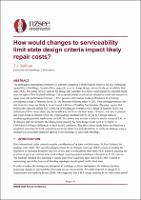How would changes to serviceability limit state design criteria impact likely repair costs?
Abstract
The earthquake engineering community is currently grappling with the need to improve the post-earthquake reparability of buildings. As part of this, proposals exist to change design criteria for the serviceability limit state (SLS). This paper reviews options for change and considers how these could impact the expected repair costs for typical New Zealand buildings. The expected annual loss (EAL) is selected as a relevant measure or repair costs and performance because (i) EAL provides information on the performance of a building considering a range of intensity levels, (ii) the insurance industry refers to EAL when setting premiums, and (iii) monetary losses are likely to be correlated with loss of building functionality. The paper argues that because the expected annual loss is affected by building performance over a range of intensity levels, the definition of SLS criteria alone may be insufficient to effectively limit losses. However, it is also explained that losses could be limited effectively if the loadings standard were to set the SLS design intensity considering the potential implications on EAL. It is shown that in order to achieve similar values of EAL in Wellington and Christchurch, the return period intensity for SLS design would need to be higher in Christchurch owing to differences in local hazard conditions. The observations made herein are based on a simplified procedure for EAL estimation and hence future research should aim to verify the findings using a detailed loss assessment approach applied to a broad range of case study buildings.

